- Table View
- List View
A Computer Called Katherine: How Katherine Johnson Helped Put America on the Moon
by Suzanne SladeThe inspiring true story of mathematician Katherine Johnson--made famous by the award-winning film Hidden Figures--who counted and computed her way to NASA and helped put a man on the moon!Katherine knew it was wrong that African Americans didn't have the same rights as others--as wrong as 5+5=12. She knew it was wrong that people thought women could only be teachers or nurses--as wrong as 10-5=3. And she proved everyone wrong by zooming ahead of her classmates, starting college at fifteen, and eventually joining NASA, where her calculations helped pioneer America's first manned flight into space, its first manned orbit of Earth, and the world's first trip to the moon!Award-winning author Suzanne Slade and debut artist Veronica Miller Jamison tell the story of a NASA "computer" in this smartly written, charmingly illustrated biography.
Comrades: A Lifetime of Friendships
by Rosita Boland'I was fascinated, moved and entertained by every page. This is the kind of book the world needs right now' DONAL RYAN_______________'My dictionary's first two definitions of 'comrade' are:A close companion.An intimate associate or friend.The third one is:A fellow soldier.My friends have been all those things to me.'In this stunning essay collection, award-winning journalist Rosita Boland explores the many friendships that have shaped her life. Surprising and beautiful, she writes about the imaginary friends of early childhood, books that have provided companionship and joy, kindred spirits met while travelling, the friend she hoped might become something more, and also the friendships that become lost over time.Life-affirming, affecting and wise, Comrades is a powerful exploration of what it is to live, to connect, and to be human in this world._______________'An absorbing journey along life's tracks and trails.' THE SUNDAY TIMES IRELAND'A moving, beautiful and deeply felt meditation on friendship, loyalty and connectedness in a disconnected world' HILARY FANNIN
Comrades on the Colca: A Race for Adventure and Incan Treasure in One of the World's Last Unexplored Canyons
by Eugene BuchananA modern-day, real life adventure, this book will take readers along for a rollicking ride through South America on a race to the bottom of the Earth. When the author first met Polish explorer, Yurek Majcherczyk on a commercial feasibility expedition down Ecuador's Quijos River in 1989, he did not know it would lead to taking part in a Polish race, stumbling upon a mummy-filled cave and even getting wrapped up in a legend linking long-lost Incan riches to a riverfront castle in Poland. As the adventurers plunge deeper and deeper into unknown territory, they discover a rival Polish team trying to usurp their goal. The author seamlessly weaves these tales with his own exploits and adventures--climaxing with a tumultuous hike out of the canyon with both teams returning to complete their race the following year.
A Concise History of Florida (Brief History Ser.)
by James C. ClarkA quick overview of the Sunshine State&’s fascinating past, with photos and illustrations included. In 1513, Spanish explorer Juan Ponce de León first set foot on Florida&’s east coast. The land he discovered was a geographic anomaly so distinctive that one day, centuries later, astronaut Neil Armstrong would say that Florida was the first shape on earth he recognized on his return from a visit to the moon. This unique state has witnessed such momentous events as the 1959 arrival of the first Cuban exiles under Fidel Castro and the 1981 launch of the Columbia—the first space shuttle. Join historian James C. Clark as he chronicles the surprising history of the Sunshine State in this concise and captivating book.
Concord
by Helen Arthur-Cornett Michael EuryWhen state legislator Stephen Cabarrus sought a compromise between quarreling Scotch-Irish and German settlers over the location of Cabarrus County's seat, his appeal led to a "concord" that gave birth to one of North Carolina's most charming cities. Not long after its 1796 founding, Concord began a transformation from an agricultural community into a textile-manufacturing mecca as captains of industry built empires exploiting the cotton that so abundantly sprouted from the region's fruitful soil. By the advent of the 1900s, textiles' prosperity encouraged an architectural renaissance within Concord's downtown, where the stately buildings, churches, and residences still stand today. While the cotton mills that made Concord famous are no more, the city has transitioned into a fast-paced motorsports center and the home of North Carolina's most popular tourist destination, Concord Mills shopping mall.
Concord-Farragut
by Doris Woods OwensIn 1787, before Concord or Farragut existed, the area was known as Campbell's Station. The settlement grew rapidly, and by 1840, it was a thriving, self-sufficient community with many businesses. In the mid-1850s, the town of Concord was established two miles south of Campbell's Station along the newly installed railroad lines, drawing many businesses from Campbell's Station. Concord prospered, but Campbell's Station remained peaceful farmland. In 1902, Farragut High School was built in Campbell's Station. The school and the post office were the glue that held the west Knox County communities together. By 1944, nearly one-third of Concord was displaced by the impoundment of Fort Loudoun Lake. Soon Campbell's Station's sprawling farms became subdivisions, and Concord's businesses, churches, and even the post office were forced to relocate to Campbell's Station, leaving Concord a sleepy village. In 1980, a large area around the school but excluding Concord was incorporated as the town of Farragut.
Concordia
by Joe Gilliam Dena BisnetteIn 1869, Concordia, Kansas, was declared the county seat of what would become Cloud County. At first, the town existed only on paper as a project being pushed by James M. Hagaman and a small group of partners. Once development started, Concordia rapidly grew to become a center of commerce south of the Republican River that eventually attracted four railroad lines. It became a town of landmarks, including several famous hotels, two opera houses, Nazareth Convent, and a thriving downtown area. Characters in the story of Concordia include French Canadian immigrants, nuns, pilots, quarreling newspaper editors, German prisoners of war, and politician Frank Carlson. Readers can enjoy visiting the community's past in the pages of Images of America: Concordia.
The Conde Nast Traveler Book of Unforgettable Journeys: Volume II
by Klara GlowczewskaAnother spellbinding trip around the globe with some of today's most celebrated writers and journalists Condé Nast Traveler is the preeminent travel magazine in the United States, boasting a readership of 3.5 million. This second collection of the award-winning magazine's best travel writings, includes essays by luminaries such as, Robert Hughes, Russell Banks, E. L. Doctorow, André Aciman, Pico Iyer, and Edna O'Brien.As the world becomes smaller and ever more accessible, interest in travel writing is only growing greater. So whether readers are preparing for their own journeys or just indulging in an armchair adventure, this new volume of The Condé Nast Traveler Book of Unforgettable Journeys will open their eyes to the world.
The Conde Nast Traveler Book of Unforgettable Journeys
by Klara Glowczewska VariousFrom the #1 travel magazine in the country, a collection of travel tales from some of today's finest writers Travel writing maintains its seemingly endless popularity, and this volume offers a particularly transporting body of work, pairing exotic locales with writers of the highest caliber: Russell Banks writes on the Everglades, Francine Prose explores the secrets of Prague, Robert Hughes takes us on a tour of Italy, and more. From the most beautiful gardens to visit in Japan to the best free things to do in Provence, this book is as enlightening as it is entertaining. Whether off to the other side of the globe or to their favorite reading chair, wanderers of every sort will find this book truly indispensable. Other featured writers and places include: Nik Cohn on Savannah Philip Gourevitch on Tanzania Shirley Hazzard on Capri Pico Iyer on Iceland and Ethiopia Nicole Krauss on Japan Suketu Mehta on the Himalayas Edna O'Brien on Bath Patricia Storace on Provence and Athens James Truman on Iran Gregor Von Rezzori on Romania Edmund White on Jordan Simon Winchester on Mount Pinatubo William Dalrymple on his pilgrimage to Santiago John Julius Norwich on the Vatican Jan Morris on Hawaii
Conejo Valley
by Jeffrey Wayne MaulhardtThe amorphous Conejo Valley today encompasses the southeastern portion of Ventura County in and around Thousand Oaks, including Newbury Park and Lake Sherwood, near where the I-101 exits Los Angeles County at Westlake Village on its way west and north. Human history in the Conejo Valley dates back to the hunting and gathering days of the Chumash Native Americans. The short Spanish and Mexican periods added a few adobe buildings, erected for respites taken by vaqueros and later cattle rustlers on these rolling grasslands north of the coastal Santa Monica Mountains. In the 19th century, a grand hotel was constructed, and a stage route was established. Grain farmers tried to tame the thirsty hills of the Conejo Valley before the arrival of scenic neighborhoods and malls after World War II.
Conesus Lake (Images of America)
by Sharon L. MistrettaConesus Lake is the westernmost of the 11 Finger Lakes. Often referred to as one of the "Little Fingers," it is located about 25 miles south of Rochester, New York. In 1924, the City of Rochester announced plans to use Conesus Lake to supplement the water supply for its residents. A year later, cottagers around the lake successfully banded together to protect Conesus's sparkling waters and preserve the area as a summer resort. Over time, the lake area has grown, and restaurants, taverns, campgrounds, and amusement parks have sprung up from the demand of the lake's many visitors. Today, four towns--Geneseo, Groveland, Conesus, and Livonia--border the approximate 18 miles of shoreline.
Coney Island
by Laura J. HoffmanConey Island is famous for so much more than just hot dogs and wild rides. At the turn of the 20th century, it was known as the "Playground of the World." In the beginning, this upscale resort area catered to the rich. Between 1897 and 1904, three lavish amusements parks opened in Coney Island. By 1920, the subway extended to Stillwell Avenue, which made Coney Island more accessible for everyone. The abundant history is remarkable, and its peaks and valleys closely resemble one of its most famous icons, the roller coaster. Coney Island hit its apex between 1910 and 1930. Afterwards, it suffered through the Great Depression, went into major decline after World War II, and hit bottom in the 1970s and 1980s. In recent years, there has been a profound revitalization effort to bring the area back to its glory days. Despite the major setback caused by Superstorm Sandy in 2012, the spirit of Coney Island is alive and well.
A Coney Island Reader: Through Dizzy Gates of Illusion
by Parascandola, Louis J.; Parascandola, JohnThis literary anthology celebrates the history and romance of Coney Island with works by some of the 19th and 20th centuries&’ greatest authors and poets. Featuring a stunning gallery of portraits by the world's finest poets, essayists, and fiction writers--including Walt Whitman, Stephen Crane, José Martí, Maxim Gorky, Federico García Lorca, Isaac Bashevis Singer, E. E. Cummings, Djuna Barnes, Colson Whitehead, Robert Olen Butler, and Katie Roiphe—this anthology illuminates the unique history and transporting experience of New York City&’s quintessential beach destination. Moody, mystical, and enchanting, Coney Island has thrilled newcomers and soothed native New Yorkers for decades. Its fantasy entertainments, renowned beach foods, world-class boardwalk, and expansive beach offer a kaleidoscopic panorama of people, places, and events that have inspired writers of all types and nationalities. It becomes, as Lawrence Ferlinghetti once wrote, "a Coney Island of the mind."
Coney Island's Wonder Wheel Park (Images of America)
by Charles DensonThe venerable Wonder Wheel, Coney Island's oldest and greatest attraction, has dominated the Coney Island skyline for more than a century. Towering over an ephemeral amusement zone long plagued by fires, floods, and ill-conceived urban renewal schemes, the magnificent steel machine has proved to be the ultimate survivor. The ride boasts impressive statistics. A combination of roller coaster and Ferris wheel, the 150-foot-tall structure weighs 200 tons, has 16 swinging cars and 8 stationary cars, and can carry 144 riders. More than 40 million passengers have taken a ride on the wheel since it was built in 1920, and during that time, it has maintained a perfect safety record. The ride is also a monument to immigrant initiative. Charles Hermann, the ride's designer, was Romanian; the original owner, Herman Garms, was German; and Denos Vourderis, who purchased and lovingly restored the aging landmark in 1983, was Greek. An official New York City landmark, the Wonder Wheel is now owned and operated by three generations of the Vourderis family as the centerpiece of their Deno's Wonder Wheel Park. The enduring saga of this iconic ride, and the family that saved it, provide a captivating chapter of Coney Island's history.
A Confederate Biography: The Cruise Of Css Shenandoah
by Dwight HughesBased primarily on the words of those who lived it, A Confederate Biography is a comprehensive narrative of the cruise of the CSS Shenandoah. More than a thrilling sea story, the journey provides a window of historical perspective on the Civil War. From October 1864 to November 1865, the officers of the Shenandoah carried the Confederacy and the conflict around the globe and to the ends of the earth through every extreme of sea and storm. Their observations looking back from the most remote and alien surroundings imaginable, along with viewpoints of those they encountered, illuminate the hearts and minds of contestants North and South. These Americans stood together in defense of their country as they understood it, pursuing a difficult and dangerous mission in which they succeeded spectacularly after it no longer mattered. Through their eyes, the potentially decisive international arena of the war, governed by complex maritime and trade law, comes alive. The neutrality, or lack thereof, of major European powers was a central concern to both sides. Shenandoah was smack in the middle of this diplomatic maelstrom and contributed to it. And within the navy, a generational clash arose between antebellum orthodoxy and a professional officer corps emerging from the new Naval Academy, rapid technological advances, contemporary social reforms, and the crucible of war. This difference was manifest between the captain of Shenandoah and his young lieutenants. The men they led, however, were a polyglot assemblage of merchant sailors of nearly every nation and color--including several Yankees and African Americans--operating within its own rigidly authoritarian and cramped society. Shenandoah herself was a magnificent vessel, the epitome of rich and ancient maritime heritages, but also a paradigm of dramatic transitions from the small wooden sailing navy to the second largest, most powerful, and technologically advanced fleet in the world. Her commerce raiding mission was a watery form of asymmetric warfare in the spirit of John Mosby, Bedford Forrest, and W. T. Sherman. It was arguably the most successful military effort of the Confederacy in terms of cost versus mission accomplished, but the strategic effectiveness of the strategy remains questionable. Shenandoah fired the last gun of the Civil War, set the land of the midnight sun aglow with flaming Yankee whalers, and, seven months after Appomattox, lowered the last Confederate banner. This is a biography of a ship and a cruise, and a microcosm of the Confederate-American experience.
Confederates Don't Wear Couture: A Tale Of Heartache, Haunting, And Hoop Skirts.
by Stephanie Kate StrohmPublishers Weekly praised the Pilgrims Don'tWear Pink author Stephanie Kate Strohm for "turning a strong heroine and a few surprises into a clever, tightly written book that will keep readers wondering who will become Libby's Mr. Darcy." This romantic sequel follows suit in high style! High-style hoopskirts, that is . . .When history nerd Libby's gay fashion designer best friend asks for help selling his gowns to the wives of Civil War reenactors, she jumps at the chance to frolick on a nineteenth-century playground. But Alabama's no sweet home: sweltering heat, no Starbucks, a vengeful ghost . . .And the boys? Miss Libby's got the North and the South fighting for her heart.
Confederates in the Attic: Dispatches from the Unfinished Civil War (Vintage Departures)
by Tony HorwitzNational Bestseller. When prize-winning war correspondent Tony Horwitz leaves the battlefields of Bosnia and the Middle East for a peaceful corner of the Blue Ridge Mountains, he thinks he's put war zones behind him. But awakened one morning by the crackle of musket fire, Horwitz starts filing front-line dispatches again this time from a war close to home, and to his own heart. Propelled by his boyhood passion for the Civil War, Horwitz embarks on a search for places and people still held in thrall by America's greatest conflict. The result is an adventure into the soul of the unvanquished South, where the ghosts of the Lost Cause are resurrected through ritual and remembrance. In Virginia, Horwitz joins a band of 'hardcore' re-enactors who crash-diet to achieve the hollow-eyed look of starved Confederates; in Kentucky, he witnesses Klan rallies and calls for race war sparked by the killing of a white man who brandishes a rebel flag; at Andersonville, he finds that the prison's commander, executed as a war criminal, is now exalted as a martyr and hero; and in the book's climax, Horwitz takes a marathon trek from Antietam to Gettysburg to Appomattox in the company of Robert Lee Hodge, an eccentric pilgrim who dubs their odyssey the 'Civil Wargasm.' Written with Horwitz's signature blend of humor, history, and hard-nosed journalism, Confederates in the Attic brings alive old battlefields and new ones 'classrooms, courts, country bars' where the past and the present collide, often in explosive ways. Poignant and picaresque, haunting and hilarious, it speaks to anyone who has ever felt drawn to the mythic South and to the dark romance of the Civil War.
Conferences and Conventions: A Research Perspective (Routledge Advances in Event Research Series)
by Judith MairConferences and conventions are one of the fastest growing areas of the events industry. This is a substantially important sector yet research into many dimensions is in its infancy. This timely book, uniquely presents a ‘state of the art’ synthesis of the research on both demand and supply sides of the industry as well as insights into how current and future trends are affecting conferences and conventions. This volume provides a critical review of the players involved in conferences and conventions; destination image and impacts; and current and future trends. The players in the industry include attendees/delegates, professional conference organisers, and association meeting planners. On the destination side, conference venues and facilities, along with convention and visitor bureaux are examined, as well as how destination image can be developed and improved. Further, this section considers the economic, social and environmental impacts of conferences and conventions. The final section considers some of the major trends that are likely to impact on the industry, including climate change, new technologies and risk and crisis management. To reflect the sector’s international nature case studies and examples from different geographical regions are included throughout. By identifying gaps in our knowledge, and presenting a collection of themes to guide future research, this book not only adds to our current knowledge, but will underpin the advancement of knowledge in the future. This book is essential reading for all those interested in Events.
Conferences and Conventions: A Global Industry (Events Management)
by Tony Rogers Peter Wynn-MoylanFully revised and updated to reflect current trends and emerging topics, the fourth edition of Conferences and Conventions: A Global Industry provides an expert-led, comprehensive introduction to, and overview of, the key elements of the global conference, convention and meetings industry. This book examines the conference industry’s origins, structure and future development, as well as its economic, social and environmental impacts. It provides an in-depth analysis of the strategies, practices, knowledge and skills required to organise memorable conferences and similar business events, with detailed descriptions of all the planning and operational processes. Following an international approach, this edition features additional sections on the increase in technological advancements and opportunities, as well as the rise of virtual and hybrid events in a post-pandemic era. Written in an accessible and engaging style, the book includes integrated case studies to highlight current issues and demonstrate theory in practice. Structured logically with useful features throughout to aid learning and understanding, this book is an invaluable resource to students following events management, hospitality and tourism courses, as well as for event planners and practitioners already working in the conference industry.
Conferences and Conventions 3rd edition: A Global Industry (Events Management)
by Tony RogersConferences and Conventions: A Global Industry 3rd edition provides a comprehensive introduction to the key elements of the global conference, convention and meetings industry. It examines the industry’s origins, structure, economic, social and environmental impacts, education, training and career opportunities, and the industry's future development. It also explores its links with the wider tourism industry, and suggests that there should be a realignment of these links, putting a greater focus on designing, executing and measuring meeting and convention contents so that they have a purposeful impact on participants, thus creating greater value for stakeholders. It suggests that there should be greater emphasis on the role that meetings play in economic, professional and educational development, promoting the benefits they provide in knowledge exchange, scientific research, technology transfer, networking and motivation and showing clearly what such business events actually accomplish. This revised 3rd edition has been updated to reflect current trends and emerging topics and achieve a more international approach. This edition has also been updated with the following features: New content on social media, web based marketing, the use of technology, experiential marketing and events, the role of trade shows in conventions,?issues of sustainability, and moves to create a profession for event management. Fully integrated and updated case studies to highlight current issues and demonstrate theory in practice. Also contains new case studies on the growth markets of Asia, Brazil and the Middle East. A detailed meetings and events industry lexicon. This book is written in an accessible and engaging style and structured logically with useful features throughout to aid students’ learning and understanding. This book is an invaluable resource to students following Events Management, Hospitality and Tourism courses. ?
Confessions from Correspondentland: The Dangers and Delights of Life as a Foreign Correspondent
by Nick BryantSince making his journalistic debut breaking into Piers Morgan's office, BBC foreign correspondent Nick Bryant has rattled Donald Rumsfeld, had tea with President Karzai, slept through 9/11, and gotten a free lunch out of the Tamil Tigers. Now casting a sideways glance at his own profession, Nick reveals the day-to-day realities of 'Correspondentland' - its glamour, its quirks, and its sometimes unsavoury practices. Learn how to evade a shoot-to-kill curfew, the media's 'rulebook' for natural disasters, and when fireproof underwear is an absolute essential.Nick Bryant is currently New York correspondent for the BBC and was formerly the BBC's Washington correspondent. He provides a window onto American politics that no insider can. From how Bush saves seats for his favorite reporters to how Clinton responds to questions about that little blue dress, Bryant discovers the dangers and delights of seeing the world through this unique and often strange perspective.Part memoir, part travelogue, part exposé, this is an unmissable insight into the world of modern reporting, and an intimate portrait of the countries Nick has come to know.
Confessions of a Traveloholic: To Travel Is To Evolve
by Ashish Raisinghani"Confessions of a Traveloholic" by Col. Ashish Raisinghani offers a captivating insight into the world of travel through the eyes of an experienced Indian Army Officer. Spanning over two decades of exploration, Raisinghani shares thirteen compelling travelogues, ranging from solo backpacking adventures to heartwarming family trips with his wife and daughter. With a keen eye for detail and a philosophical approach, Raisinghani delves into the essence of travel, distinguishing between mere tourists and true travelers who seek immersive experiences and continuous growth. Through vivid storytelling and practical insights, this book inspires readers to embark on their own journeys of self-discovery, embracing the joy of exploration and the transformative power of travel.
Confessions of an Event Planner: Case Studies from the Real World of Events--How to Handle the Unexpected and How to Be a Master of Discretion
by Judy AllenFor anyone planning events—student, novice, or experienced professional—Confessions of an Event Planner is an “apprenticeship in a book.” This insider’s guide takes you on a narrative journey, following a fictional event planning company that stages various types of events around the world for many different clients. While other books, college courses, and training programs give you the theory and how-to of the profession, Confessions of an Event Planner reveals the real world of event planning and what can happen—usually the unexpected—on an event program when actual participants are added to the event planning design and execution mix. In a climate of media scrutiny and corporate scandals, event planners must be masters of discretion, knowing how to avoid and deal with everything from sexual romps to financial shenanigans, to chainsaw wielding salesmen dead set on “re-landscaping” the grounds of the resort they’re staying at. From an event planner who’s seen it all and knows how to deal with it all, comes practical first-hand advice delivered in an entertaining and accessible format. Each chapter is set in a unique location, with a cast of characters, and a host of challenges and problems to overcome—from the boardroom to the resort guest bedrooms. Readers learn what they can come up against, how to problem solve creatively on the fly, get ideas for staging spectacular events, and see the principles of event planning in action. The scenario in each chapter is introduced by an outline of what will be covered in the chapter, and each chapter concludes with a series of review questions to explore key issues and stimulate reflection or discussion for individuals or groups. Ideal as a companion to Judy Allen’s six other event planning books, as a textbook in event planning courses, or as a professional training tool Confessions of an Event Planner prepares planners for what they can expect once they start working in the world of corporate and social event planning, and will help decision-makers set company policies, procedures and protocol and promote discussion about codes of conduct in the office and offsite.
Confines: Navegando aguas árticas y antárticas
by Javier ReverteTras el éxito de En mares salvajes, Javier Reverte vuelve al frío con su pluma cálida y cargada de humor. ¿Adónde ir cuándo se ha pateado tanto mundo como Javier Reverte? Como él mismo dice, el planeta se hace mucho más grande conforme vas conociéndolo mejor y siempre hay nuevos paisajes que se abren al sueño y a la vocación de conocer. Por eso ha escogido como destino en esta ocasión los extremos boreal y austral del globo: dos navegaciones por los mares árticos y antárticos, realizadas con pocos meses de diferencia, que constituyen la entraña de este nuevo libro viajero. Una primavera polar transcurre a bordo de un barco de investigación noruego, se adentra en las islas árticas de Svalbard y continúa hacia el norte, en latitudes ya muy próximas al Polo Norte. En su relato, no solo nos habla de las peripecias de la navegación, sino de las exploraciones en busca del extremo septentrional del planeta, de los efectos del cambio climático, del calentamiento global y de las amenazas que penden, por causa de todo ello, sobre la humanidad. Octubre en el Cabo de Hornos recorre los canales, islas, estrechos, penínsulas, cordilleras y mares recoletos de Tierra de Fuego, y llega a la isla del Cabo de Hornos. Nos habla de los viajes de Magallanes, Raleigh, Fitz-Roy, Darwin y otros exploradores, y de Ushuaia, la ciudad del fin del mundo, y de su famoso penal. «Para mí, el hecho de viajar es lo que importa, y el cómo se lleve a cabo el viaje no me parece lo sustancial. La cuestión es moverse, irse, largarse del propio terruño con los sentidos abiertos, expuesto a dejarse cautivar por todo cuanto hay de novedoso en los caminos del mundo, lo mismo si son sendas de tierra que si han sido trazados, invisibles, sobre el agua o sobre el viento. En grupo o en solitario, en avión o en autocar, de día o de noche, por unas cuantas jornadas o por una larga temporada, rumbo al sur o rumbo al norte, hacia el este o el oeste, pernoctando en hoteles de lujo o en cabañas mugrientas... lo esencial es moverse, ya digo, "con el camino bajo los pies y el cielo sobre la cabeza", como pedía Stevenson. Solo así aprendemos a mirarnos en los espejos del mundo.»Javier Reverte
Conflict and Hostility in Hotels, Restaurants, and Bars
by Conrad LashleyThis book critically explores conflict and hostility in a range of hospitality settings and from a broad stakeholder perspective.The provision of accommodation, food, and drink in commercial settings has conflict at its core because the commercial transaction between hosts and guests can result in a clash of expectations between the server and served. These service encounters involve stakeholders other than immediate personnel and their clients; owners, managers, local communities, and regulatory and licensing authorities also have concerns about the hotels, restaurants, and bars in their midst. The book recognises that these different stakeholders frequently have common interests but are also in conflict as their needs and goals compete with others. By reviewing these multi-agenda perspectives, the contributors offer new insights into topics such as conflict theory within the hospitality industry, human trafficking, employee conflict, dysfunctional leadership, tall poppy syndrome, and the impacts of over-tourism on host communities.Written by leading international academics, this significant volume will be of interest to students, researchers, and academics interested in critical hospitality studies, sociology, and business, as well as anthropology and culture studies.
























